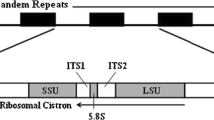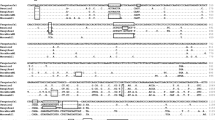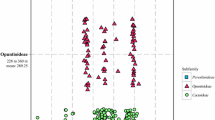Abstract
This study investigates the ribosomal RNA transcript secondary structure in corals as confirmed by compensatory base changes in Isopora/Acropora species. These species are unique versus all other corals in the absence of a eukaryote-wide conserved structural component, the helix III in internal transcriber spacer (ITS) 2, and their variability in the 5.8S-LSU helix basal to ITS2, a helix with pairings identical among all other scleractinian corals. Furthermore, Isopora/Acropora individuals display at least two, and as many as three, ITS sequence isotypes in their genome which appear to be capable of function. From consideration of the conserved elements in ITS2 and flanking regions, it appears that there are three major groups within the IsoporaAcropora lineage: the Isopora + Acropora “longi” group, the large group including Caribbean Acropora + the Acropora “carib” types plus the bulk of the Indo-Pacific Acropora species, and the remaining enigmatic “pseudo” group found in the Pacific. Interbreeding is possible among Caribbean A. palmata and A. cervicornis and among some species of Indo-Pacific Acropora. Recombinant ITS sequences are obvious among these latter, such that morphology (as represented by species name) does not correlate with common ITS sequence. The combination of characters revealed by RNA secondary structure analyses suggests a recent past/current history of interbreeding among the Indo-Pacific Acropora species and a shared ancestry of some of these with the Caribbean Acropora. The unusual absence of helix III of ITS2 of Isopora/Acropora species may have some causative role in the equally unusual instability in the 5.8S-LSU helix basal to ITS2 of this species complex.




Similar content being viewed by others
References
Chen CA, Wallace CC, Wolstenholme J (2002) Analysis of the mitochondrial 12S rRNA gene supports a two-clade hypothesis of the evolutionary history of scleractinian corals. Mol Phylogenet Evol 23:137–149
Chen CA, Chang CC VWN, Chen CH, Lein YT, Lin HE, Dai CF, Wallace CC (2004) Secondary structure and phylogenetic utility of the ribosomal internal transcribed spacer 2 (ITS2) in scleractinian corals. Zool Stud 43:759–771
Coleman AW (2007) Pan-eukaryote ITS2 homologies revealed by RNA secondary structure. Nucleic Acids Res 35:3322–3329
Concepcion GT, Medina M, Toonen RJ (2006) Noncoding mitochondrial loci for corals. Mol Ecol Notes 6:1208–1211
Cote CA, Greer CL, Peculis BA (2002) Dynamic conformational model for the role of ITS2 in pre-RNA processing in yeast. RNA 8:786–797
Cuif JP, Lecointre G, Perrin C, Tillier A, Tillier S (2003) Patterns of septal biomineralization in Scleractinia compared with their 28S rRNA phylogeny: a dual approach for a new taxonomic framework. Zool Scripta 32:459–473
Fukami H, Knowlton N (2005) Analysis of complete mitochondrial DNA sequences of three members of the Montastraea annularis coral species complex (Cnidaria, Anthozoa, Scleractinia). Coral Reefs 24:410–417
Fukami H, Omori M, Hatta M (2000) Phylogenetic relationships in the coral family Acroporidae, reassessed by inference from mitochondrial genes. Zool Sci 17:689–696
Fukami H, Budd AF, Paulay G, Sola-Cava A, Chen CA, Iwao K, Knowlton N (2004) Conventional taxonomy obscures deep divergence between Pacific and Atlantic corals. Nature 427:832–835
Hatta M, Fukami H, Wang WQ, Omori M, Shimoike K, Hayashibara T, Ina Y, Sugiyama T (1999) Reproductive and genetic evidence for a reticulate evolutionary history of mass-spawning corals. Mol Biol Evol 16:1607–1613
Hellberg ME (2006) No variation and low synonymous substitution rates in coral mtDNA despite high nuclear variation. BMC Evol Biol 6:24
Kenyon JC (1997) Models of reticulate evolution in the coral genus Acropora based on chromosome numbers: parallels with plants. Evolution 51:756–767
Le Goff-Vitry MC, Rogers AD, Baglow D (2004) A deep-sea slant on the molecular phylogeny of Scleractinia. Mol Phylogenet Evol 30:167–177
Márquez LM, Miller DJ, MacKenzie JB, van Oppen MJH (2003) Pseudogenes contribute to the extreme diversity of nuclear ribosomal DNA in the hard coral Acropora. Mol Biol Evol 20:1077–1086
Medina M, Collins AG, Takaoka TL, Kuehl JV, Boore JL (2006) Naked corals: skeleton loss in Scleractinia. Proc Natl Acad Sci USA 103:9096–9100
Proschold T, Harris EH, Coleman AW (2005) Portrait of a species: Chlamydomas reinhardtii. Genetics 170:1601–1610
Romano SL, Cairns SD (2000) Molecular phylogenetic hypotheses for the evolution of scleractinian corals. Bull Mar Sci 67:1043–1068
Romano SL, Palumbi SR (1996) Evolution of scleractinian corals inferred from molecular systematics. Science 271:640–642
Romano SL, Palumbi SR (1997) Molecular evolution of a portion of the mitochondrial 16S ribosomal gene region in scleractinian corals. J Mol Evol 45:397–411
Shearer TL, van Oppen MJH, Romano SL, Woerheide G (2002) Slow mitochondrial DNA sequence evolution in the Anthozoa (Cnidaria). Mol Ecol 11:2475–2487
Stanley GDJ, Fautin DG (2001) The origins of modern corals. Science 291:1913–1914
van Oppen MJH, Willis BL, Miller DJ (1999) Atypically low rate of cytochrome b evolution in the scleractinian coral genus Acropora. Proc Roy Soc Lond B Biol Sci 266:179–183
van Oppen MJH, Willis BL, van Vugt HWJA, Miller DJ (2000) Examination of species boundaries in the Acropora cervicornis group (Scleractinia, Cnidaria) using nuclear DNA sequence analyses. Mol Ecol 9:1363–1373
van Oppen MJH, McDonald BJ, Willis B, Miller DJ (2001) The evolutionary history of the coral genus Acropora (Scleractinia, Cnidaria) based on a mitochondrial and a nuclear marker: reticulation, incomplete lineage sorting, or morphological convergence? Mol Biol Evol 18:1315–1329
van Oppen MJH, Woerheide G, Takabayashi M (2002a) Nuclear markers in evolutionary and population genetic studies of scleractinian corals and sponges. Proc 9th Int Coral Reef Symp Bali 1:131–138
van Oppen MJH, Willis BL, van Rheede T, Miller DJ (2002b) Differences in spawning time and genetic structuring among reproductively compatible corals: an example from the Acropora aspera species group. Mol Ecol 11:1363–1376
Veron JEN (1995) Corals in space and time. UNSW Press, Sydney
Vollmer SV, Palumbi SR (2002) Hybridization and the evolution of reef coral diversity. Science 296:2023–2025
Vollmer SV, Palumbi SR (2004) Testing the utility of internally transcribed spacer sequences in coral phylogenetics. Mol Ecol 13:2763–2772
Wallace CC, Chen CA, Fukami H, Muir PR (2007) Recognition of separate genera within Acropora based on new morphological, reproductive and genetic evidence from Acropora togianensis, and elevation of the subgenus Isopora Studer, 1878 to genus (Scleractinia: Astrocoeniidae; Acroporidae). Coral Reefs 26:231–239
Wei NV, Wallace CC, Dai C-F, Moothien Pillay KR, Chen CA (2006) Analyses of the ribosomal internal transcribed spacers (ITS) and the 5.8S gene indicate that extremely high rDNA heterogeneity is a unique feature in the scleractinian coral genus Acropora (Scleractinia; Acroporidae). Zool Stud 45:404–418
Willis BL, van Oppen MJH, Miller DJ, Vollmer SV, Ayre DJ (2006) The role of hybridization in the evolution of reef corals. Annu Rev Ecol Syst 37:489–517
Author information
Authors and Affiliations
Corresponding author
Rights and permissions
About this article
Cite this article
Coleman, A.W., van Oppen, M.J.H. Secondary Structure of the rRNA ITS2 Region Reveals Key Evolutionary Patterns in Acroporid Corals. J Mol Evol 67, 389–396 (2008). https://doi.org/10.1007/s00239-008-9160-y
Received:
Revised:
Accepted:
Published:
Issue Date:
DOI: https://doi.org/10.1007/s00239-008-9160-y




